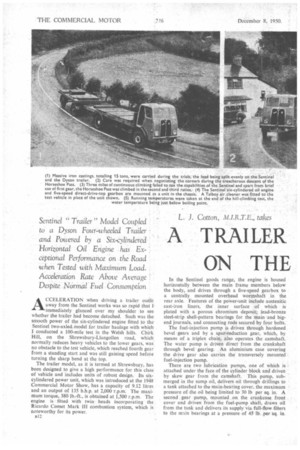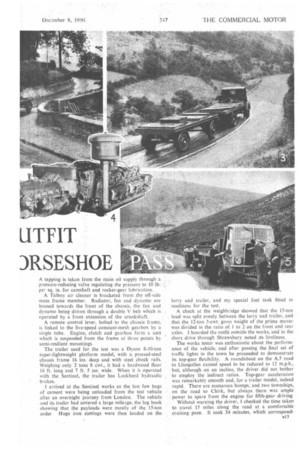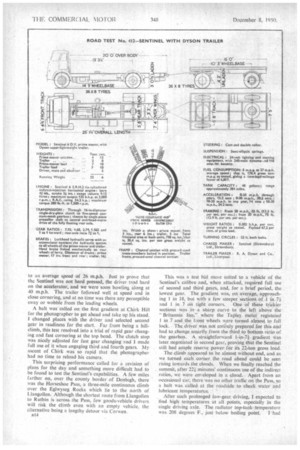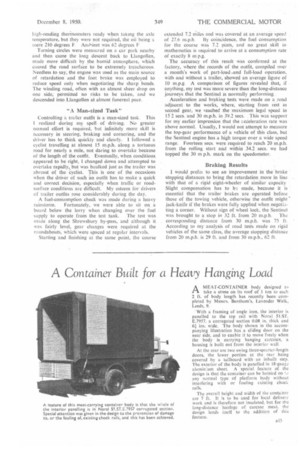L. J. Cotton, Al.I.R.T.E., takes A TRAILER
Page 46

Page 47

Page 48

Page 49

If you've noticed an error in this article please click here to report it so we can fix it.
LITFIT ON THE JRSESHOE
Sentinel " Trailer " Model Coupled to a Dyson Four-wheeled Trailer and Powered by a Six-cylinciered Horizontal Oil Engine has Exi• ceptional Performance On the Road when Tested with Maximum Load. Acceleration Rate Above Average Despite .Normal Fuel Consumption
ACCELERATION when driving a trailer outfit away from the Sentinel works was so rapid that I immediately glanced over my shoulder to see whether the trailer had become detached. Such was the smooth power of the six-cylindered engine fitted to the Sentinel two-axled model for trailer haulage with which I conducted a 100-mile test in the Welsh hills. Chirk Hill, on the Shrewsbury-Llangollen road, which normally reduces heavy vehicles to the lower gears, was no obstacle to the test vehicle, which reached fourth gear from a standing start and was still gaining speed before turning the sharp bend at the top.
The trailer model, as it is termed at Shrewsbury, has been designed to give a high performance for this class of vehicle and includes units of robust design. Its sixcylindered power unit, which was introduced at the 1948 Commercial Motor Show, has a capacity of 9.12 litres and an output of 135 b.h.p. at 2,000 r.p.m. The maximum torque, 380 lb.-ft., is obtained at 1,500 r.p.m. The engine is fitted with twin heads incorporating the Ricardo Comet Mark III combustion system, which is noteworthy for its power. In the Sentinel goods range, the engine is housed horizontally between the main frame members below the body, and drives through a five-speed gearbox to a centrally mounted overhead wormshaft in the rear axle. Features of the power-unit include austenitic cast-iron liners, the inner surface of which is plated with a porous chromium deposit; lead-bronze steel-strip shell-pattern bearings for the main and bigend journals, and connecting rods secured by four bolts.
The fuel-injection pump is driven through hardened bevel gears and by a spur-reduction gear, which, by means of a triplex chain, also operates the camshaft. The water pump is driven direct from the crankshaft through bevel gearing. An aluminium case covering the drive gear also carries the transversely mounted fuel-injection pump.
There are two lubrication pumps, one of which is attached under the face of the cylinder block and driven by skew gear from the camshaft. This pump, submerged in the sump oil, delivers oil through drillings to a tank attached to the main-bearing cover, the maximum pressure of the oil being limited to 30 lb per sq. in. A second gear pump, mounted on the crankcase front cover and driven from the fuel-pump shaft, draws oil from the tank and delivers its supply via full-flow filters to the main bearings at a pressure of 45 lb. per sq. in. A tapping is taken from the main oil supply through a pressure-reducing valve regulating the pressure to 10 lb. per sq. in. for camshaft and rocker-gear lubrication.
A Talboy air cleaner is bracketed from the off-side main frame member. Radiator, fan and dynamo are housed towards the front of the chassis, the fan and dynamo being driven through a double V belt which is operated by a front extension of the crankshaft.
A remote control lever, bolted to the chassis frame, is linked to the five-speed constant-mesh gearbox by a single tube. Engine, clutch and gearbox form a unit which is suspended from the frame at three points by semi-resilient mountings.
The trailer used for the test was a Dyson 8-10-ton super-lightweight platform model, with a pressed-steel chassis frame 16 ins. deep and with steel chock rails. Weighing only 2 tons 8 cwt., it had a hardwood floor 16 ft. long and 7 ft. 5 ins. wide. When it is operated with the Sentinel, the trailer has Lockheed hydraulic brakes.
I arrived at the Sentinel works as the last few bags of cement were being unloaded from the test vehicle after an overnight journey from London. The vehicle and its trailer had covered a large mileage, the log book showing that the payloads were mostly of the 15-ton order Huge iron castings were then loaded on the lorry and trailer, and my special fuel tank fitted in readiness for the test.
A check at the weighbridge showed that the 15-ton load was split evenly between the lorry and trailer, and that the 12-ton 3-cwt. gross weight of the prime mover was divided in the ratio of 1 to 2 on the front and rear axles. I boarded the outfit outside the works, and in the short drive through Shrewsbury noted its liveliness.
The works tester was enthusiastic about the performance of the vehicle, and after passing the final set of traffic lights in the town he proceeded to demonstrate its top-gear flexibility. A roundabout on the A.5 road to Llangollen caused speed to be reduced to 12 m.p.h., but, although on an incline, the driver did not bother to employ the indirect ratios. Top-gear acceleration was remarkably smooth and, for a trailer model, indeed rapid. There are numerous humps, and two townships, on the road to Chirk, but always there was ample power to spare from the engine for fifth-gear driving Without warning the driver, I checked the time taken to travel 15 miles along the road at a comfortable cruising pace. It took 34 minutes, which corresponds to an average speed of 26 m.p.h. Just to prove that the Sentinel was not hard pressed, the driver trod hard on the accelerator, and we were soon bowling along at 40 m.p.h. The trailer followed well at speed and in close cornering, and at no time was there any perceptible sway or wobble from the leading wheels.
A halt was calledon the first gradient at Chirk Hill for the photographer to get ahead and take up his stand.
changed places with the driver and selected second gear in readiness for the start. Far from being a hillclimb, this test resolved into a trial of rapid gear changing and fast cornering at the top bend. The clutch stop was nicely adjusted for fast gear changing pnd I made full use of it when engaging third and fourth gears. My ascent of Chirk was so rapid that the photographer had no time to reload his camera.
This surprising performance called for a revision of plans for the day and something more difficult had to he found to test the Sentinel's capabilities. A few miles farther on, over the county border of Denbigh, there was the Horseshoe Pass, a three-mile continuous climb over the Eglwyseg Rocks which lie to the north of Llangollen. Although the shortest route from Llangollen to Ruthin is across the Pass, few goods-vehicle drivers will risk the climb even with an empty vehicle, the alternative .being a lengthy detour via Corwen.
1i14
This was a test hill mole suited to a vehicle of the Sentinel's calibre and, when attacked, required full use of second and third gears, and, for a brief period, the lowest gear. The gradient was, otj average, approaching 1 in 18, but with a few steeper 'sections of 1 in 74
and 1 in 7 On tight -corners. One of these trickier sections was in a sharp curve to the left above the "Britannia Inn," where the Tapley meter registered I in 7 and the front wheels were turned almost to full lock.. The drivel' was not entirely prepared for this and had to change.smartly from the third to bottom ratio of the gearbox. A straightforward 1-in-74 gradient was later, negotiated in second gear, proving that the Sentinel still had ample reserve power for its 22-ton gross load.
The climb appeared to be ,almost without end, and as we turned each corner the road ahead could be seen rising towards the clouds. When we finally reached the summit, after 221 minutes' continuous use of the indirect ratios, we were. enveloped in a cloud. Apart from an occasional car, there was no other traflic on the Pass, so a halt was called. at the roadside to cheek water and lubricant temperatures: • After such prolonged low-gear driving, I expected to find high temperatures at all points, especially in the single driving axle. The radiator top-tank-temperature
was. 208 degrees F., just below boiling point, I 'had
high-reading thermometers ready when taking the axle temperature, but they were not required, the oil being a mere 210 degrees F Ambient was 62 degrees F Turning circles were measured on a car park nearby and then came the long descent back to Llangollen, made more difficult by the humid atmosphere, which caused the road surface to be extremely treacherous Needless to say, the engine was used as the main source of retardation and the foot brake was employed to reduce speed only when negotiating the sharp bends. The winding road, often with an almost sheer drop on one side, permitted no risks to be taken, and we descended into.Llangoilen at almost funereal pace.
"A Man-sized Task" Controlling a trailer outfit is a man-sized task. This I realized during my spell of driving. No greater manual effort is required, but infinitely more skill is necessary in steering, braking and cornering, and the driver has to think quickly and clearly. 1 followed a cyclist travelling at almost 15 m.p.h. along a tortuous road for nearly a mile, not daring to overtake because of the length of the outfit. Eventually, when conditions appeared to be right, I changed down and attempted to overtake rapidly,, but was baulked just as the trailer was abreast of the cyclist. This is one of the occasions when the driver of such ànoutfit has to make a quick and correct. decision, especially. when traffic or roadsurface conditions are difficult. My esteem for drivers of trailer outfits rose considerably during the day.
A fuel-consumption check was made during a heavy rainstorm. Fortunately, we were able to sit ort a board below the lorry when changing over the fuel supply to operate from the test tank. The test was made along the Shrewsbury by-pass, and although it was fairly level, gear changes were required at the roundabouts, which were spaced at regular intervals.
Starting and finishing at the same point, the course extended 7.2 miles and was covered at an average speed of 27.6 m.p.h. By coincidence, the fuel consumption for the course was 7.2 Dints, and no great skill in mathematics is required to arrive at a consumption rate of exactly 8 m pg.
The accuracy of this result was confirmed at the factory, where the records of the outfit, compiled over a month's work of part-load .and full-load operation, with and without a trailer, showed an average figure of 10 m.p.g. A comparison of figures revealed that, if anything, my test was more severe than the long-distance journeys that the Sentinel is normally performing Acceleration and braking tests were made on a _road adjacent to the works, where, starting from rest in second gear, we reached the maximum legal speed in 152 sees. and 30 m.p.h. in 39.2 secs. This was support for my earlier impression that the acceleration rate was above normal. Usually, I would not attempt to measure the top-gear performance of a vehicle of this class, but the Sentinel engine has a high torque over a wide speed range. Fourteen secs. were required to reach 20 m.p.h. from the rolling start and within 34.2 .secs. we had topped the 30 m.p.h. mark on the speedometer,
Braking Results
would prefei to see an improvement in the brake stopping distances to bring the retardation more in line with that of a rigid eight-wheeler of similar capacity Slight compensation has to b made, because it is essential that the trailer brakes are operated before those of the towing vehicle, otherwise the outfit might jack-knife if the brakes were fully applied when negotia• ting a corner. Without sign of wheel lock, the Sentinel was brought to a stop in 32 ft. from 20 m.p.h. The corresponding distance from 30 m.p.h. was 75 ft According to my analysis of road tests made on rigid vehicles of the same class, the average stopping distance from 20 m.p.h. is 29 ft. and from 30 m.p.h., 62 ft.




























































































